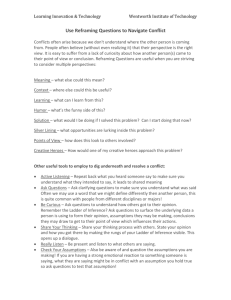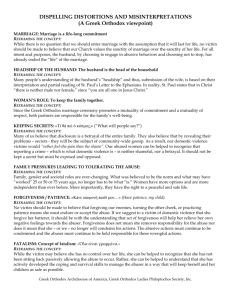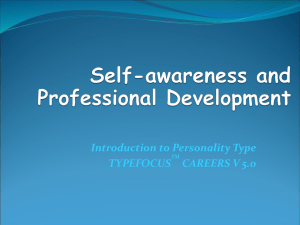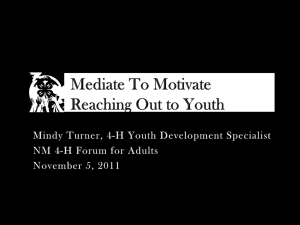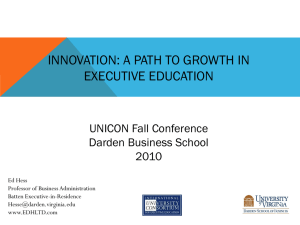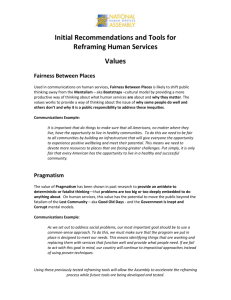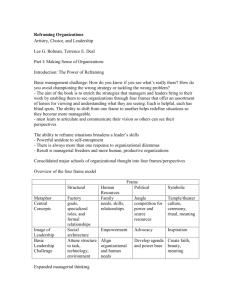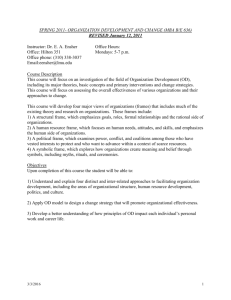Chapter 1
advertisement
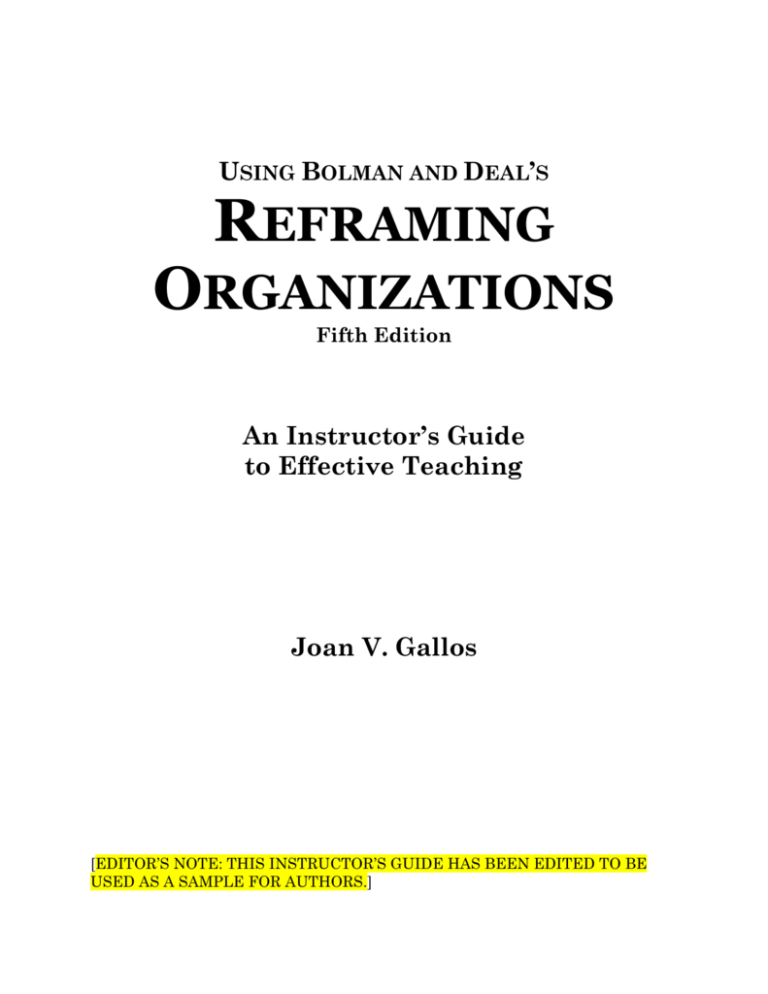
USING BOLMAN AND DEAL’S REFRAMING ORGANIZATIONS Fifth Edition An Instructor’s Guide to Effective Teaching Joan V. Gallos [EDITOR’S NOTE: THIS INSTRUCTOR’S GUIDE HAS BEEN EDITED TO BE USED AS A SAMPLE FOR AUTHORS.] CONTENTS PREFACE ....................................................................................................................................................................4 PART 1. AN INTRODUCTION TO REFRAMING ORGANIZATIONS.............................................................. 10 Overall Purpose of the Book .............................................................................................................................. 10 Philosophy Behind the Book .............................................................................................................................. 10 The Power of the Book in the Classroom: A Rationale for Its Use .................................................................... 12 Features That Distinguish Reframing Organizations from Other Books About Organizations ......................... 13 PART 2. TEACHING WITH REFRAMING ORGANIZATIONS ......................................................................... 16 Central Teaching Issues ..................................................................................................................................... 16 Developmental Implications of Reframing Courses ........................................................................................... 17 Student Responses to Reframing Courses .......................................................................................................... 22 Creating a Productive Learning Environment ................................................................................................... 25 PART 3. CHAPTER-BY-CHAPTER NOTES AND TEACHING SUGGESTIONS .......................................... 30 CHAPTER 1. INTRODUCTION: THE POWER OF REFRAMING ..................................................................... 30 CHAPTER 2. SIMPLE IDEAS, COMPLEX ORGANIZATIONS ......................................................................... 47 CHAPTER 3. GETTING ORGANIZED ................................................................................................................ 59 CHAPTER 4. STRUCTURE AND RESTRUCTURING ....................................................................................... 73 CHAPTER 5. ORGANIZING GROUPS AND TEAMS......................................................................................... 79 CHAPTER 6. PEOPLE AND ORGANIZATIONS ................................................................................................ 86 CHAPTER 7. IMPROVING HUMAN RESOURCE MANAGEMENT .............................................................. 100 CHAPTER 8. INTERPERSONAL AND GROUP DYNAMICS .......................................................................... 108 CHAPTER 9. POWER, CONFLICT, AND COALITION .................................................................................... 123 CHAPTER 10. THE MANAGER AS POLITICIAN ............................................................................................ 137 CHAPTER 11. ORGANIZATIONS AS POLITICAL ARENAS AND POLITICAL AGENTS .......................... 145 CHAPTER 12. ORGANIZATIONAL CULTURE AND SYMBOLS .................................................................. 153 CHAPTER 13. CULTURE IN ACTION .............................................................................................................. 168 CHAPTER 14. ORGANIZATION AS THEATER ............................................................................................... 172 CHAPTER 15. INTEGRATING FRAMES FOR EFFECTIVE PRACTICE ........................................................ 182 CHAPTER 16. REFRAMING IN ACTION: OPPORTUNITIES AND PERILS ................................................. 189 CHAPTER 17. REFRAMING LEADERSHIP ..................................................................................................... 195 CHAPTER 18. REFRAMING CHANGE IN ORGANIZATIONS ....................................................................... 220 CHAPTER 19: REFRAMING ETHICS AND SPIRIT ......................................................................................... 232 CHAPTER 20. BRINGING IT ALL TOGETHER: CHANGE AND LEADERSHIP IN ACTION ...................... 241 CHAPTER 21. EPILOGUE: ARTISTRY, CHOICE, AND LEADERSHIP ......................................................... 244 PART 4. SAMPLE SYLLABI AND SUPPORT MATERIALS .......................................................................... 249 SAMPLE SYLLABI ............................................................................................................................................. 249 GUIDELINES FOR PERSONAL CASE PAPER ................................................................................................. 277 GUIDELINES FOR ORGANIZATIONAL FIELD STUDIES ............................................................................. 279 DETAILED ROLE DESCRIPTIONS FOR RFK HIGH SCHOOL ...................................................................... 288 APPENDIX A. SOURCES FOR CASES ............................................................................................................... 291 APPENDIX B. SOURCES FOR VIDEOS............................................................................................................. 292 PREFACE Teaching is always challenging. Students bring diverse experiences, needs, expectations, motivations, and learning styles to the classroom. Instructors counter with their own educational philosophies, preferences for pedagogy, personal styles, and decisions about content focus and course design. When the chemistry is right, the experience is glorious. Learning is simple, natural, and exciting. Students and instructor part ways with warm memories as well as new knowledge. When things go awry, classes seem endless, and instructors spend more time corralling disengaged students than facilitating learning and growth. The semester ends with mutual revenge: teachers give grades and students fill out course evaluations. Teaching about organizations and management adds its own complexities to the educational challenges. The field is filled with gray areas. There are few simple rules or straightforward solutions that guarantee organizational productivity and managerial success. The theory base is peppered with hypotheses masquerading as proven facts, multiple explanations for the same phenomena, and enough contradictions to confuse even the most dedicated and enthusiastic students. All this stands in sharp contrast to the disciplines of more bottom-line-oriented colleagues—the economists, accountants, engineers, and basic scientists who also lay claim to students’ time and interests. What does all this mean for the organizational behavior classroom? How can instructors create exciting and engaging courses that maximize learning for students? How can they teach students to translate conceptual learning and good intentions into effective practice? That is what this instructor’s guide is all about. It is based on the premise that Reframing Organizations: Artistry, Choice, and Leadership offers a unique opportunity for teaching about organizations, good leadership, and effective management. Using Reframing Organizations as the basic text, it is possible to design courses that teach students to: 1. Become more discriminating consumers of organizational theory and advice. 2. Understand and work with the ambiguity and complexity in both the discipline’s theory base and organizational reality. 3. Translate the flood of organizational solutions and leadership prescriptions into usable diagnostic tools and more elegant action strategies. This guide will show you how. The guide offers advice and suggestions on when, where, why, and how to use Reframing Organizations. It examines how to teach the art and practice of reframing. It explores why a four-frame approach to organizations—viewing organizations through structural, human resource, political, and symbolic lenses—is so empowering for undergraduates, graduate students, and executive audiences alike. It probes the connections between a multiframe approach and developmental growth for students. It offers advice and suggestions for tailoring courses to different student audiences—providing everything from insights into the educational philosophies that underpin courses on reframing to the nuts and bolts of suggested syllabi and class designs. PART 1. AN INTRODUCTION TO REFRAMING ORGANIZATIONS Reframing Organizations is more than a standard organizational behavior (OB) text. Understanding its unique nature and contributions, as well as its underlying philosophy and values, clarifies its possibilities in the classroom. OVERALL PURPOSE OF THE BOOK Reframing Organizations is written for present and future leaders and managers— those who envision themselves actively engaged in the struggles to tame and befriend the too-often unruly organizational beast. The authors’ primary purpose in writing the book was to sort through organization theory and research: to bring readers understandings that are genuinely important and useful to practitioners, as well as simple ways of using this information on a day-to-day basis. By examining what is known about structure, human resources, politics, and symbols, the authors offer easy access to and a quick handle on central organizational concerns culled from a hundred years’ worth of theory and research. The book, however, is not a standard, chapter-by-chapter march through a traditional list of topics. Rather, it is intended as a readable and usable synthesis and integration of present understanding about organizations. Reframing Organizations is unique in its attempt both to name the isolated traditions and major theoretical perspectives—structural, human resource, political, and symbolic—that characterize organization and management thinking and to propose direct links across these distinct traditions for good professional practice. The authors provide a comprehensive framework for understanding organizational theory and behavior, as well as a good historical overview of the field. The authors’ second purpose in writing the book was to show how reframing and a four-frame approach to organizations, management, and good leadership work. The authors present many real-life cases and organizational examples from the four different perspectives. They ground their central assertions for more practically minded readers; they demonstrate the power and usefulness of reframing and the skills essential for applying multiple perspectives to the same organizational event. Four questions—What is going on structurally? What is going on from a human resource perspective? What is going on politically? What is going on symbolically?— echo throughout the book, challenging readers to cultivate good diagnostic habits and develop an appreciation for comprehensive views of organizational happenings. PART 3. CHAPTER-BY-CHAPTER NOTES AND TEACHING SUGGESTIONS This section of the manual provides teaching notes for each chapter in Reframing Organizations. The notes include an overview of each chapter’s central ideas, a chapter outline, a list of the major case examples, alternative ways to think about teaching the material, and suggested cases, films, activities, and exercises. (Cases and training films are identified with names or acronyms such as Hartwick and HBS, which refer to sources listed in Appendix A.) CHAPTER 1. INTRODUCTION: THE POWER OF REFRAMING CHAPTER 1 OVERVIEW Chapter 1 Summary ____________________________________________ In Chapter 1, the authors introduce the concepts of reframing (viewing situations from multiple perspectives) and frames (cognitive lenses on the world that affect what you see and what it means). They propose four basic lenses or frames for strengthening managerial diagnosis and action: a structural frame, a human resource frame, a political frame, and a symbolic frame. (The four frames are summarized in Table 3.1.1.) The authors assert that managers and leaders often bring too few ideas and too many habitual responses to organizational problems and challenges. They rely on a limited cognitive perspective to make sense out of the world and remain blind to other options. They delude themselves in thinking theirs is “the only way” to handle a particular problem. Such thinking hinders managerial effectiveness and abilities to understand and respond to the complexities of life in today’s turbulent world. Successful managers and leaders require more comprehensive perspectives. They need multiple lenses and skills in reframing—looking at old problems in a new light, as well as confronting new challenges with different tools and reactions. Reframing expands understandings, responses, timing, and styles that managers apply to problems. It helps them translate managerial good intentions into effective action. Learning Outcomes for Chapter 1 ______________________________ After studying this chapter, students will be able to: Appendix A. Sources for Cases 1. Explain why people tend to view the world from a single perspective and why viewing any situation in this way leads to a limited—and perhaps fatally flawed—understanding of the situation. 2. Describe the concept of reframing, or viewing situations in a number of different ways, and the benefits of reframing. 3. Discuss the broad outlines of four powerful frames for viewing organizations: the structural, human resource, political, and symbolic frames. Key Terms in Chapter 1 _________________________________________ Frame: Cognitive lens on the world that affects what we see and what it means. Reframing: Viewing situations from multiple perspectives. Structural frame: A frame for viewing organizations that focuses on the architecture of organization—the design of units and sub-units, rules and roles, goals and policies—that shape and channel decisions and activities. Human resource frame: A frame for viewing organizations that emphasizes that management requires an understanding of people, with their strengths and foibles, reason and emotion, desires and fears. Political frame: A frame for viewing organizations that sees organizations as competitive arenas characterized by scarce resources, competing interests and struggles for power and advantage. Symbolic frame: A frame for viewing organizations that focuses on issues of meaning and faith. Case Examples in Chapter 1 ____________________________________ Steve Jobs Rajat Gupta Hurricane Katrina, Homeland Security, and President Bush “Cha Cha” Rowan greets an intruder Executive browsing in the management section of a bookstore Conflict between the Federal Bureau of Investigation and the Central Intelligence Agency Appendix A. Sources for Cases SUGGESTIONS FOR TEACHING CHAPTER 1 The central ideas in Chapter 1 revolve around people’s need to recognize their limited views on everyday life and to expand the ways in which they make sense out of their world by viewing organizational events through multiple lenses. In teaching these central ideas, instructors can focus on: 1. Understanding the process of framing (sense-making) and reframing. 2. Engaging in self-diagnosis and exploring personal theories. 3. Examining the content of the four frames. Teaching methods appropriate for each approach are described in the sections that follow. Student exercises keyed to the approaches appear in “Student Exercises for Chapter 2.” Chapter 1: A Focus on Reframing _______________________________ Reframing is a difficult concept for many students to grasp, especially concrete thinkers or people who, for developmental reasons, want the “one right answer.” Reframing demands a tolerance for ambiguity, an appreciation of how reality is socially constructed, and skills in relative thinking—developmentally sophisticated capacities. For these reasons, instructors should not assume that students understand the concept of reframing from reading alone. They may want to use this chapter as a way of both offering students opportunities to experience multiple perspectives on the same event (reframing) and diagnosing where their students are. The following resources may be of help. CHAPTER 1: FILMS OR VIDEOS FOCUSING ON REFRAMING Movies and video clips offer an engaging and powerful way to explore reframing issues, and the rapid growth of online video sites such as YouTube has vastly increased the range of available material. Downloading software apps such as YouTube Video Downloader (shareware, free to try) make it relatively easy to download video clips, save them to disk, and use them in class. Abbott and Costello’s “Who’s on First?” (more than one version is available on YouTube) is a classic comic routine that depends on a misunderstanding resulting from divergent frames (interpretations): Abbott, as manager of a baseball team, calmly explains that Who is on first and What is on second. Costello can’t get it because he figures Who and What have to be questions, not answers. Note that, as is often true with frame conflicts, the misunderstanding could be easily resolved if either party stepped back to reflect and try a different approach, instead of plunging resolutely down the same path. Appendix A. Sources for Cases Reframing is an important concept in Neurolinguistic Programming (NLP), an approach to counseling and personal development. NLP and Reframing Organizations differ in many ways, but share a similar understanding of reframing. NLP practitioners have devoted considerable attention to developing techniques for reframing. An online search for “NLP reframing” will lead to many examples in both text and video formats. Additional film possibilities include the following, all of which illustrate well the social construction of reality and the ways in which different personal and cultural perspectives frame the meaning of events: Rude Awakening (1989). Two hippies return to New York City after twenty years in a Central American commune to find that people are no longer out protesting to save the world. An alternative is to show a movie excerpt in which the central characters illustrate reframing in action. Two such scenes from the movies Dead Poets Society are (1) the scene in which Professor Keating has students stand on his desk to learn to see the world from a different perspective and (2) the scene in which he asks students to rip the analytic introduction from their poetry books. CHAPTER 1: CASES FOCUSING ON REFRAMING Case discussions offer several possibilities for introducing students to multiple perspectives. Establishing an “ECL” Culture in China: Organizational Difference or National Difference? (HKU155, available from HBS case services) raises a classic issue in international business: When you build a business in another country, do you adapt your management practices to the local culture or try to get the local culture to adapt to your organization? Transformation of Enron, 1986–2001 (available from Darden Business Publishing, University of Virginia, http://store.darden.virginia.edu/) is a multimedia CD-ROM case containing a wealth of information on Enron’s strategy, culture, and leadership in the period leading up to the collapse, including excellent video interviews with Jeffrey Skilling and other key executives. Most of the material tells the story of Enron’s transformation from a conservative gas pipeline company in the mid-1980s to a high flyer by 2000, but postscripts have been added to update events after the fall. CHAPTER 1: ACTIVITIES FOCUSING ON REFRAMING Art can be a powerful trigger for discussions about reframing. Escher’s work, for example, shows how perception influences what we see. Like the old vase- Appendix A. Sources for Cases and-face figure from Gestalt psychology, where the viewer sees either an old woman’s face or a pedestal vase, Escher’s art is often frame-breaking: no one frame can make sense of the image, but alternative frames are incompatible. Reframing can lead to completely different interpretations of Escher’s figures. (Many of Escher’s figures can be viewed online at http://www.worldofescher.com/gallery/. Check out, for example, “Relativity,” in which one person’s up is another person’s down.) Many current events and social issues, if handled sensitively, provide opportunities to explore framing effects. Why, for example, do members of different groups have such different perceptions of abortion rights, assisted suicide, the Israel–Palestine situation, and so forth? Discussions can focus on the values, information, and perceptions that inform personal theories. (For another idea, see Exercise 1.1 in “Student Exercises for Chapter 1.”) CHAPTER 1: READING FOCUSING ON REFRAMING Fiction can serve as a starting point for illustrating the concept of reframing, exploring the action implications of alternative frames, or examining the interconnections among culture, values, and framing. Seedfolks, by Paul Fleischman, for example, is an award-winning folktale suitable for audiences of all ages. The book chronicles the creation of a caring community in a neighborhood of strangers. Thirteen very different voices— old, young, urban, rural, Asian, African American, Hispanic, European, tough, haunted, ailing, and hopeful—tell the story of a simple garden on a trash-filled urban lot that transforms lives, transcends differences, and celebrates the healing power of community. The short paperback can be a reading assignment or the basis for a staged reading in class with part assigned to students. The book is also perfect for understanding alternative frames as an often-unacknowledged component of diversity. Modern fictional works whose form and content reflect a unique cultural perspective provide another way to access these issues. Each of the following works creates characters who see and talk about their world view: their choices flow from the values and learnings of their countries and cultures. Balzac and the Little Chinese Seamstress by Dai Sijie describes two city boys transferred to the country during the Cultural Revolution and reads like a Chinese brush painting. It explores well the power of the arts to reframe even the grimmest of situations. The Life of Pi by Yann Martel. Appendix A. Sources for Cases Chapter 1: A Focus on Self-Diagnosis and Personal Theories ______ The central ideas in Chapter 1 also lend themselves to a focus on self-diagnosis and students’ personal theories. CHAPTER 1: ACTIVITIES FOCUSING ON SELF-DIAGNOSIS AND PERSONAL THEORIES Bolman and Deal have developed several instruments for self-diagnosis, including a short, self-scored instrument to assess individual frame preferences. A new, online version of the instrument is available on the Wiley.com Reframing Organizations instructor companion website. A downloadable earlier version can also be found, along with instructions for use, at http://www.leebolman.com/frames_selfrating_scale.htm. Instructors can also devise their own mechanisms for encouraging students to think about and diagnose their private theories and beliefs. Following are some suggestions. (Also see Exercises 1.2, 1.3, and 1.4 in “Student Exercises for Chapter 1.”) Use TAT-type pictures or illustrations from magazine advertisements and ask students to write and then compare their stories of the pictured event. Use minicases, and ask students to diagnose the frame preference implicit in their proposed solutions. Chapter 1: A Focus on the Content of the Four Frames ____________ A third teaching focus for Chapter 1 is the content of the four frames. CHAPTER 1: FILMS OR VIDEOS FOCUSING ON FRAME CONTENT One option for focusing on the content of the frames is to show four short film clips that capture the essence of each frame. Students can explore the contrasts among the clips and their reactions to each. Popular films, newscast feature stories, and interview programs such as 20/20, 60 Minutes, Meet the Press, and so on are filled with possibilities for illustrating the central assumptions and approaches of each frame. (Instructors can contact their local stations or the network producers of these programs for a copy and/or permission to use them for educational purposes. See Appendix B for other sources of videos and films.) Hollywood’s view of organizations is often biased toward an emphasis on political machinations, but students who look carefully can find examples of every frame in films like Margin Call, The Social Network, The Pursuit of Happyness, Up in the Air, Office Space, The Hudsucker Proxy, Lord of War, Working Woman, 9 to 5, Wall Street, Boiler Room, Disclosure, Gung Ho, Appendix A. Sources for Cases Norma Rae, Apollo 13, and any of the Godfather trilogy. A number of excellent films are set in schools, including Freedom Writers, Stand and Deliver, Dead Poets Society, Dangerous Minds, Lean on Me, Mr. Holland’s Opus, and The School of Rock. (Film suggestions for specific frames can be found in the teaching notes for those chapters.) CHAPTER 1: CASES FOCUSING ON FRAME CONTENT Instructors might want to use a case to get students looking at data with structural, human resource, political, and symbolic lenses. (For an activity focusing on frame content, see Exercise 1.5 in “Student Exercises for Chapter 1.”) Brief cases, such as HBS classics like Dashman Company (HBS 9-642-001) or Road to Hell (HBS 9-480-074), or more recent cases like Clayton Industries: Peter Arnell, Country Manager for Italy; Calveta Dining Services, Inc.: A Recipe for Growth?; and Martha Rinaldi: Should She Stay or Should She Go? often work well early in a course when students (or instructor) may be unfamiliar with the case method. For more experienced management audiences, more complex cases such as Taran Swan at Nickelodeon Latin America, RFK High (in Bolman and Deal, Chapter 20), Suzanne de Passe at Motown Productions (HBS 487042), Richard Grasso and the NYSE, Inc. (A) (HBS 405051), and Gordon Bethune at Continental Airlines (HBS 9-406-073) are rich in elements of each perspective. A dramatic and challenging government example is Hurricane Katrina (A) and (B), available from the Harvard Kennedy School of Government Case Services. A rich voluntary sector case is Aruna Roy and the Birth of a People’s Movement in India (Kennedy School Case 1929.0). Roy’s story is discussed in Chapter 10. CHAPTER 1: HISTORICAL AND THEORETICAL OVERVIEW FOCUSING ON FRAME CONTENT An alternative teaching design is to provide students with an overview and understanding of the historical and theoretical context for the four frames: the “one hundred years of organizational theory in thirty minutes” lecture. Instructors can begin at the turn of the century, briefly lay out the historical roots of the structural frame in early industrial psychology—students love a short dramatic re-enactment of Frederick Winslow Taylor’s infamous conversations with Schmidt to increase the laborer’s productivity—outline the central concepts and values, and illustrate how those ideas and beliefs are carried forward by modern-day structural thinkers. Instructors can then do the same for the human resource, the political, and the symbolic perspective, in that order, illustrating not only how the advent and heyday for each frame coincides with a very different period in U.S. and world history but also how each frame, Appendix A. Sources for Cases to some extent, arose from a recognition of significant gaps in the previous perspective’s beliefs about the organizational and management world. Students appreciate seeing this big picture laid out visually on the blackboard, especially before they begin to examine smaller pieces of individual frames. It offers a map of what they will study over the course of the term and helps them accept the contrasts and the potential conflicts between the various frames. Instructors can draw on the historical materials and imagery in Perrow’s article “The Short and Glorious History of Organizational Theory” (Organizational Dynamics, Summer 1973). They may want to stress the emotional undertones in the ideological battles among those who support each of the frames, so that students can appreciate the frames as more than a sterile, intellectual vehicle to compartmentalize facts. Viewing the history of the discipline as a morality play, in which the “forces of light and truth” have battled the “forces of darkness,” encourages students to appreciate each frame as a critical element in a more complete understanding of organizational complexity. Ambitious instructors might want to consult E. Bursk, D. Clark, and R. Hidy’s The World of Business: A Selected Library of the Literature of Business from the Accounting Code of Hammurabi to the 20th Century “Administrator’s Prayer,” vol. 1, 2, and especially 3 (New York: Simon & Schuster, 1962) for relevant frame-related quotations from sources as diverse as the Bible, modern poetry, George Washington, Rod Serling, Gandhi, Samuel Gompers, Charles Dickens, and Cicero. CHAPTER 1: ACTIVITIES FOCUSING ON FRAME CONTENT Finally, it is also possible to explore events that are happening in class. Looking at the first class meeting or the syllabus from the perspective of each frame can be a simple yet powerful way for students to test their understanding of the content and relevance of the frames. Or instructors may want to design an experiential activity in which students explore what is really going on from a structural, human resource, political, and symbolic perspective. (An example is Exercise 1.6 in “Student Exercises for Chapter 1.”) STUDENT EXERCISES FOR CHAPTER 1 EXERCISE 1.1 ____________________________________________________________ Focus: Understanding the Process of Reframing This exercise is meant to stretch students’ abilities to move outside of their own dominant frame. Choose a situation—an ambiguous memo from a department chair, a newspaper article, a hypothetical minicase—in which there are many possible explanations for what is going on. Ask students to list all possible explanations for the event, then work in small groups to sort through their lists, Appendix A. Sources for Cases come up with their best guess of what is “really going on here,” and provide a rationale for their choices. This lets contrasting frames surface, illustrates how differently people view events, and reminds students how personal interpretation and “good hunches” play a major role in defining social situations. PART 4. SAMPLE SYLLABI Course Overview and Purposes ___________________________________ Organizations are necessary but complex “beasts.” They exist for the simple reason that groups of people can accomplish more than individuals working alone. At the same time, there is complexity in such collective social action, and organizational life is often marked by a number of recurring and difficult problems. While there is some consensus about the problems of participating in modern organizations (the possibility of worker frustration and alienation in large systems; the difficulties in utilizing the human resources available, the problems in walking the fine line between necessary specialization, coordination, and bureaucratic red tape; and so on), there is little agreement about how to solve the problems. Organizational hierarchies, MBO, quality circles, company songs, sensitivity training, job redesign, employee training programs, and shop-floor quality-ofworklife efforts are a sampling of the many ways in which organizational theorists and participants have attempted to tame the unruly beast. Implicit in each of the solutions is a particular perspective on organizational life and a focus on organizational structures, human relationships, political processes, or organizational symbols. The purpose of this course is to help students understand the complexities of organizations. It is designed to provide an exposure to theories of organization, important organizational issues and processes, and a variety of strategies and tactics useful to successful organizational leaders and followers alike. Scope of the Course _____________________________________________ The field of organization theory currently includes a number of different major conceptual perspectives. Some view the field as fragmented. Others prefer to see it as pluralistic. Many introductory courses present only one or two perspectives. Initially, that approach may be simpler and less confusing, but in the long run it will be less valid and less helpful. This course will develop four major views of organizations (frames) that comprehend much of the existing theory and research on organizations. 1. A structural frame, which emphasizes goals, roles, formal relationships, and the rational side of organization. Appendix A. Sources for Cases 2. A human resource frame, which focuses on human needs, attitudes, and skills and emphasizes the human side of organization. 3. A symbolic frame, which explores how organizations create meaning and belief through symbols, including myths, rituals, and ceremonies. 4. A political frame, which examines power, conflict, and coalitions among those who have vested interests to protect and want to advance within a context of scarce resources. The course will begin by viewing organizations through each of the four frames separately. In the long run, the goal is to be able to use all four frames: the ability to view organizations simultaneously as machines, families, theaters, and jungles— the key to a deeper understanding of the complexities of organizations. Course Requirements ____________________________________________ Readings are required for most classes. Required readings are found in the syllabus and are to be prepared for the class on the date listed. Additional recommended readings are also provided for frame groups that want further materials to prepare their class presentations and for those interested in exploring some “classics” in the organizational literature. 2. Class participation in discussions and activities is critical. Most activities will be held during regular class times, although groups may find a need for additional out-of-class meetings to coordinate their class presentations. 3. Participation in a small group whose assigned task is a group presentation to teach one of the four frames to the entire class is also required. 4. One written assignment is required: a final paper in which you use the four frames to analyze an assigned case situation (maximum twenty pages). 1. Grading _________________________________________________________ A letter grade will be provided to all students. The makeup of the grade is as follows: Class participation: 25 percent. Group presentation: 25 percent. Final paper: 50 percent. Class Topics and Readings _______________________________________ Class 1. Introduction and Overview: Contracting, Group Formation, and Team Building. Class 2. Introduction to Reframing: Learning, Perception, and Frames. Appendix A. Sources for Cases Required reading: Bolman and Deal, Chapters 1 and 2. Recommended reading: C. Perrow, “The Short and Glorious History of Organization Theory,” Organizational Dynamics, Summer 1973. Class 3. The Structural Frame 1: Exploring the Terrain (Structural Group Presentation). Required reading: Bolman and Deal, Chapters 3, 4, and 5. Senge, The Fifth Discipline (New York: Doubleday/Currency, 1990), Chapters 1–5. Case: Campbell and Bailyn’s Boston Office: Managing the Reorganization. Recommended reading: C. Perrow, Complex Organizations: A Critical Essay, 3rd ed. (New York: Random House, 1986), Chapters 1, 4, 5, and 6. Study questions: 1. What are the major assumptions and concepts of the structural frame? 2. What changes in its industry and customers were affecting Campbell & Bailyn in 2007? 3. What were the strengths and weaknesses of the C & B brokerage division prior to the changes described in the case? 4. In the light of the changes in the marketplace, was creating KAT a good idea? If not, what should Ken Winston have done? Note: Campbell and Bailyn is recommended here because it is a relatively simple case in which the structural issues are relatively easy to grasp.
